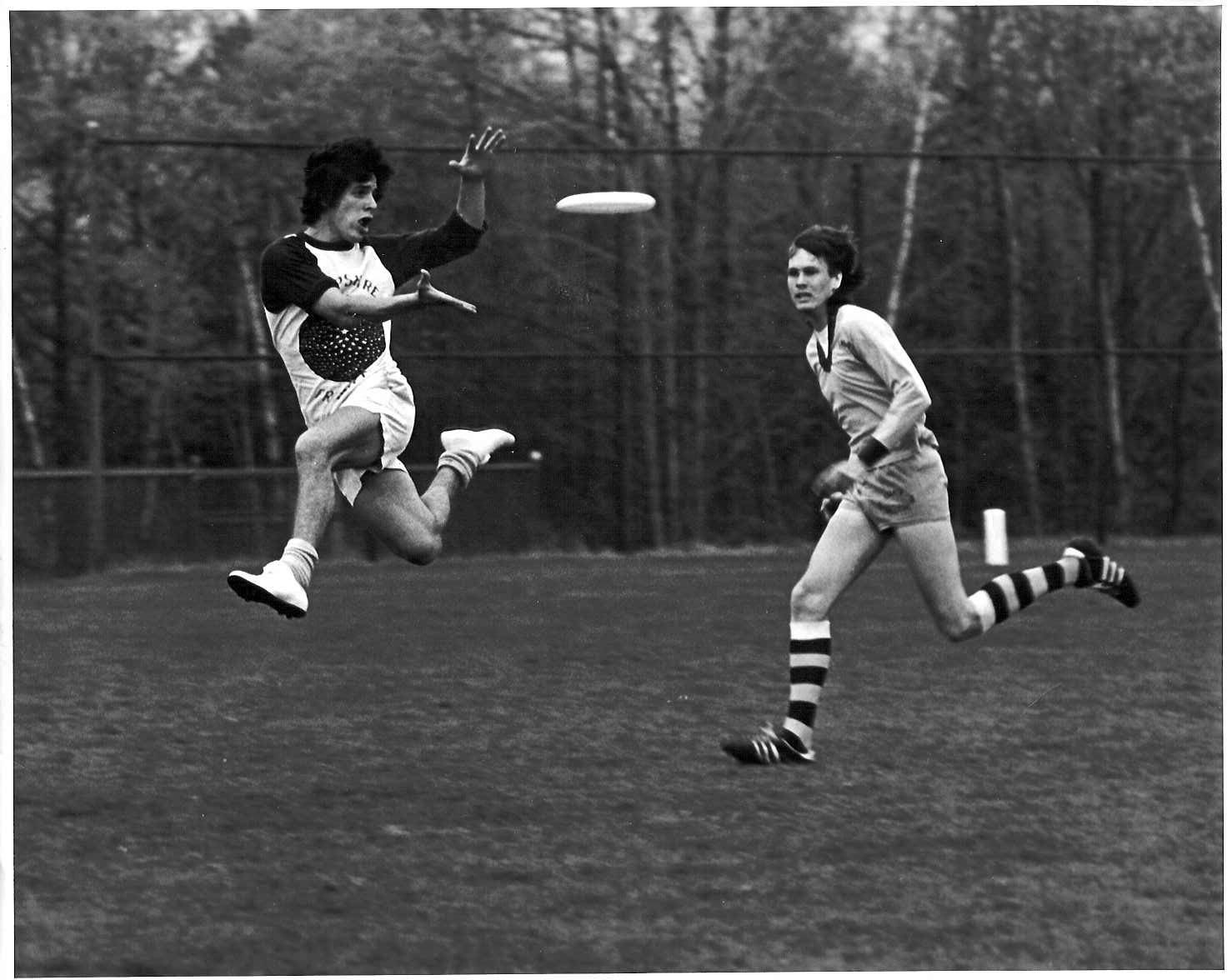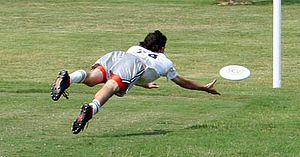Ultimate Frisbee originated at Columbia High School in 1968. Students in Maplewood, New Jersey, created it as a game between school teams.
Ultimate Frisbee, a sport combining the non-stop movement of soccer with the aerial passing skills of football, took roots in a high school setting before rapidly expanding. This unique game emphasizes sportsmanship and respect, known as the “Spirit of the Game,” which remains a core principle as the sport continues to grow.
Played with a flying disc, the objective of Ultimate is to score points by catching the disc in the opposing end zone. Its founding stemmed from a desire for an inclusive, co-ed sport that could be played without expensive equipment. Fueled by its accessibility and spirited community, Ultimate Frisbee quickly spread to college campuses and beyond, leading to formalized rules and competitive leagues around the world.
Contents
Roots Of A Modern Sport
Ultimate Frisbee stands today as a sport with a unique blend of speed, grace, and spirit. A game that began with a simple toss of a disc has grown into a highly competitive sport recognized worldwide. Yet, it all started with humble beginnings.
The Birth of Ultimate FrisbeeThe Birth Of Ultimate Frisbee
In the 1960s, a group of students at Columbia High School in Maplewood, New Jersey, invented Ultimate Frisbee. Joel Silver, inspired by the fluid action of Frisbee Football, proposed the idea. His pitch led to the first documented game in 1968. The game combined elements of football, soccer, and basketball, but notably, it was the Frisbee, a flying disc, at the heart of play.
In their school parking lot, the original rules were drafted. Balsam, Hines, and Hellring sketched the foundation of Ultimate Frisbee. This moment marked the official launch of a new sport. The rules emphasized fair play and the “Spirit of the Game,” which remains a defining aspect of Ultimate Frisbee to this day.
Influences and OriginationInfluences And Origination
Various influences shaped Ultimate Frisbee. The founding students borrowed concepts from established sports to create something fresh. They viewed existing sports through a creative lens, resulting in a game that values sportsmanship and joy.
The core structure of Ultimate borrowed from football’s end zones and soccer’s continuous play. Like basketball, it required pivoting and a defensive strategy. With these influences, Ultimate Frisbee forged its identity:
- Non-stop action and quick disc movement
- Pivoting like in basketball, for strategic advantage
- Focus on teamwork and coordination
- Use of end zones for scoring, from football
- Emphasis on the Spirit of the Game, a unique sportsmanship code
Ultimate Frisbee’s origination from these sports elements ensured its acceptance and growth. Today, it enjoys a dedicated following across the globe. To capture the true essence of competition and community, look no further than the flying disc on a sunny afternoon.

Credit: discsportshistory.com
Flying Disc Sports Precursors
Flying disc sports, like Ultimate Frisbee, didn’t just appear out of thin air. These games have a rich history with several key developments leading up to the first toss of a Frisbee. Here’s how flying discs began their journey, setting the stage for Ultimate Frisbee’s birth.
Frisbie Pie Company Connection
The story of the flying disc starts in the late 19th century with the Frisbie Pie Company. The company’s pies came in tin plates that employees and customers alike discovered could be turned upside down and thrown. They made a unique “whirring” sound, capturing the attention of passersby. College students in the Northeastern United States started to play catch with these pie tins, yelling “Frisbie!” to avoid collisions. This game led to what we now call flying disc sports.
Development Of The Flying Disc
The first official flying disc wasn’t a repurposed pie tin but a designed sporting good. Walter Morrison envisioned a flying saucer that could glide through the air with stability. In 1948, Morrison sold his design, and by 1957, the Wham-O toy company named this plastic disc the “Frisbee,” playing on the Frisbie Pie Company’s name. It marked a critical step in the evolution of disc sports.
Throughout the 1960s, this new toy’s popularity soared. People loved the ease of tossing it around at the beach, in parks, or in their backyards. The invention of disc-based games wasn’t far behind. These developments laid the groundwork for somebody to ask, “What if we turned this into a sport?”
The Foundational Game Takes Shape
The journey of Ultimate Frisbee is a story of simplicity morphing into a global sensation. The sport began humbly, but it wasn’t long before the foundational game took shape, weaving its way into the fabric of recreational and competitive athletics. As we explore its origins, we uncover the creative thinkers and milestones that shaped its existence.
Jared Kass And The Basic Rules
A pivotal figure in Ultimate’s history, Jared Kass, along with fellow students, brought Ultimate Frisbee to life in 1968. The game merged football’s energy with the ease of a flying disc. Its core philosophy was spirited play, inclusivity, and self-officiation, principles that persist today.
The initial rules laid down by Kass emphasized fun and fairness:
- Player Respect: No referees, with disputes settled by the players themselves.
- Field Setup: A rectangular play area with end zones where points are scored.
- Scoring: Catching the disc in the opponent’s end zone equals one point.
- Turnovers: Dropped passes, interceptions, or out-of-bounds throws cause a change of possession.
First Game And Spread To Schools
The game that would become Ultimate Frisbee first took flight in a high school parking lot in Maplewood, New Jersey. The thrill of play and easy-to-grasp rules fueled its spread. With a Frisbee as the only equipment needed, students could easily start their games.
Ultimate Frisbee quickly expanded its reach:
- Columbia High School: Became the incubator where the first official game was played.
- College Campuses: Gained popularity as students brought the game to their universities.
- International Growth: The game leaped across borders and is now played worldwide.
Tournaments and leagues formed rapidly, solidifying Ultimate’s position in the sports world. As school teams took root, competitive play sharpened the rules and honed the skills of players.

Credit: www.vul.ca
Growth And Formalization
The sport of Ultimate Frisbee has experienced rapid growth and formalization since its inception. From a casual pastime to a sport with international recognition, key developments have shaped its journey. These advancements include the formation of governing bodies and the standardization of rules, which have been pivotal in establishing Ultimate Frisbee as a competitive sport. Let’s delve deeper into these transformative moments in its history.
Formation Of The Upa
In 1979, Ultimate players sought to bring structure to the sport. This led to the creation of the Ultimate Players Association (UPA). The UPA, now known as USA Ultimate, brought organizational support. It led to coordinated tournaments and leagues across the United States. The UPA was vital in:
- Promoting the sport nationally.
- Facilitating competition at all levels.
- Providing resources and support for players.
Standardizing The Rulebook
In the early days, rules varied by region, making consistent play challenging. The need for standardization was clear. The UPA took on the important task of creating a unified set of rules. In 1981, the first official rulebook was released. This development:
| Impacted Area | Details |
|---|---|
| Consistency | Ensured players everywhere followed the same regulations. |
| Gameplay | Clarified fouls, scoring, and player conduct. |
| Competition | Allowed fair and equitable matches. |
With these enhancements, Ultimate Frisbee became more structured, setting the stage for further growth and global recognition.
International Expansion And Recognition
The story of Ultimate Frisbee is one of a humble sport growing beyond borders. International expansion and recognition trace the journey from college campuses to worldwide acclaim.
From Campus To Global
Ultimate Frisbee started at American colleges in the 1960s. Its spirit of fair play sparked interest worldwide. Thanks to enthusiastic players, the sport flew past its U.S. cradle.
- 1975: The first game outside the U.S. in England.
- 1980s: Teams and clubs emerge globally.
- Modern times: People play Ultimate in over 80 countries!
Ultimate In The World Games
In 2001, Ultimate Frisbee leapt onto the international multi-sport stage. It debuted in the World Games, a prestigious event. Ultimate’s display of athleticism and respect won hearts.
| Year | Location | Impact |
|---|---|---|
| 2001 | Akita, Japan | First appearance, global attention. |
| 2005 | Duisburg, Germany | Increased participation, sport growth. |
| 2009+ | Various | Continued success, more fans. |

Credit: en.wikipedia.org
Modern Ultimate Frisbee Culture
Ultimate Frisbee, often just called Ultimate, is more than a sport. It’s a community that celebrates sportsmanship, skill, and fun. From college campuses to city leagues, the culture surrounding Ultimate Frisbee is vibrant and diverse. It brings together athletes of all skill levels in a game that is both competitive and inclusive. Let’s delve into what makes Ultimate Frisbee’s culture truly stand out today.
Spirit Of The Game Philosophy
At the core of Ultimate Frisbee is the “Spirit of the Game,” a philosophy that champions fair play, respect, and joy in every match. Unlike other sports, Ultimate relies on self-officiating, where players call their fouls and settle disputes through discussion. This unique aspect fosters a tighter-knit community.
- Players prioritize honesty and integrity.
- Teams celebrate with high-fives and cheers.
- Festivals and tournaments often feature a Spirit score.
Current Popularity And Media Coverage
Ultimate Frisbee has soared from humble beginnings to a sport enjoyed worldwide. Rising interest has spurred media attention, with matches now streamed online and covered by various sports networks. Exciting highlights make their way onto social media, inspiring a new generation of players.
| Year | Participation Increase | Media Outlets Covering Ultimate |
|---|---|---|
| 2010 | Moderate | Local Networks |
| 2020 | High | International Sports Channels, Social Media |
Schools, clubs, and professional leagues continue to introduce Ultimate to new audiences. Tournaments attract teams from all over the globe, showcasing a melting pot of culture centered on the love for the game.
Frequently Asked Questions On How Did Ultimate Frisbee Start
How Is Ultimate Frisbee Initiated?
Ultimate Frisbee begins with a “pull,” where one team throws the disc to the opposing team to start play. This kickoff throw resembles a kickoff in football, setting the game in motion.
How Did The Frisbee Start?
The Frisbee originated from pie plates that students flung around at Yale University in the 1940s. Walter Morrison refined this idea and created the plastic flying disc we recognize today, which Wham-O later marketed as the “Frisbee” in 1957.
What Are 5 Interesting Facts About Ultimate Frisbee?
Ultimate Frisbee was invented in 1968 at Columbia High School, New Jersey. The game uniquely incorporates a ‘Spirit of the Game’ philosophy, emphasizing sportsmanship. It’s played in over 80 countries. No referees are typically present; players self-officiate. Ultimate Frisbee became a World Flying Disc Federation recognized sport in 1981.
What 3 Sports Is Ultimate Frisbee A Combination Of?
Ultimate Frisbee combines elements of soccer, basketball, and American football. Each sport influences its teamwork, agility, and scoring methods.
Conclusion
As we’ve explored, Ultimate Frisbee’s origins are as spirited as the game itself. From a simple idea to a global phenomenon, it’s clear this sport offers more than just athletic enjoyment. It fosters community, sportsmanship, and a love for friendly competition.
Embrace the game’s rich history and consider joining the millions who’ve discovered the joy of Ultimate Frisbee.